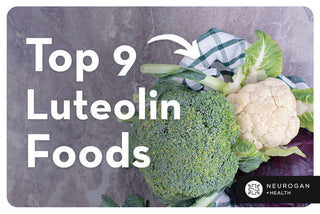Luteolin is a naturally occurring flavonoid with antioxidant and immune-supporting properties found in foods like parsley, celery, broccoli, and chamomile tea — but you'd actually need to consume large quantities of these foods to get enough daily luteolin to reach the potential benefits found in research, which isn't always practical.
That's why it's much more convenient to take supplements containing luteolin to enrich your diet for specific health goals, as it's much easier to stay consistent with supplements. Luteolin supplements are typically sourced from plants and undergo a refining process to purify the luteolin in standardized doses.
Luteolin Food Sources
Luteolin can be found naturally in a vegetable-rich diet, but you won't see very high concentrations of it. The highest source of luteolin is radicchio which has almost 38mgs per 100 g serving size.
Let's take a closer look at how much luteolin you can find in purple leaf lettuce, parsley, celery, and other foods:
|
Food |
Serving Size |
Luteolin Content Per Serving |
Source |
|
Radicchio (Purple Leaf Lettuce) |
100 g |
37.98 mg |
[1] |
|
Parsley (Fresh) |
5 g |
1 mg |
[2] |
|
Celery |
200 g |
2-4 mg |
[2] |
|
Green Bell Pepper |
100 g |
1-13 mg |
[2] |
|
Chamomile Tea (Dried) |
2 g |
1 mg |
[2] |
|
Broccoli |
200 g |
1-15 mg |
[2] |
|
Cabbage |
200 g |
1-2 mg |
[2] |
|
Rosemary |
2 g |
1-13 mg |
[2] |
|
Perilla Leaf (Dried) |
2 g |
1-16 mg |
[2] |
Keep in mind that the quantity of luteolin is an estimate. There's a lot of variation in luteolin content based on the plant variety, growing condition, and how it's prepared before eating it.
Adding these luteolin-rich foods into your diet is a good idea for supporting antioxidant intake, but it's not the most reliable way to get high doses of luteolin.
What is the Highest Source of Luteolin?
The highest natural food source of luteolin is radicchio, also known as purple leaf lettuce. This bitter leafy vegetable has approximately 37.98 mg of luteolin per 100-gram serving, making it one of the most luteolin-dense foods available.

Parsley also ranks as a significant source of luteolin, particularly when eaten fresh. A 5-gram serving of parsley (about 1 tablespoon) has around 1 mg of luteolin, which can add up when used as a garnish or in salads.
Luteolin vs. Food Sources
Our Neurogan Health Luteolin Tablet Supplement contains 200 mg of luteolin per serving for a concentrated dose in a convenient form. To compare, radicchio contains approximately 37.98 mg of luteolin per 100 grams, which means you would need to eat roughly 528 grams of radicchio to match the amount in one tablet.
In other words, very unrealistic.
To give you a better idea, this is about the same as eating 5–6 salad plates of radicchio. While radicchio is an excellent natural source of luteolin, achieving this amount through diet alone would require consuming a significant volume daily, which isn't practical (or very fun) for most people.
A luteolin supplement of any kind ensures you can reach the desired intake of this flavonoid consistently and easily without the need for large servings of specific foods. However, incorporating luteolin-rich foods like radicchio, parsley, and green bell peppers into your diet is still a good idea to enjoy additional nutrients, fiber, and variety alongside supplementation.
Can You Get Foods With Luteolin and Quercetin?
Yes, many foods contain both luteolin and quercetin, like parsley, celery, broccoli, and green bell peppers. Quercetin is another naturally occurring flavonoid known for its antioxidant and immune-supporting properties, which usually complements the benefits of luteolin.
Fresh Foods & Supplementing Luteolin for Balance
Luteolin supplements are the most practical option to consistently boost the intake of this potent flavonoid without having to eat large amounts of specific foods daily.

With concentrated doses, you can find the best Luteolin Tablets here for a reliable support for antioxidant and healthy immune system benefits.
With that being said, it's still equally important to include luteolin-rich foods in your diet, like radicchio, parsley, and broccoli, as these whole foods also contain additional nutrients, fiber, and plant compounds that contribute to overall health. This allows yourself to enjoy the best of both worlds — convenience and a balanced diet without any harmful side effects.
Resources:
-
Veganalyze. (n.d.). Luteolin food sources list. Retrieved January 17, 2025, from https://veganalyze.com/luteolin_foods_sources_list.html
-
Vast Diversity. (n.d.). Luteolin foods. Retrieved January 17, 2025, from https://www.vastdiversity.com/luteolin-foods/





